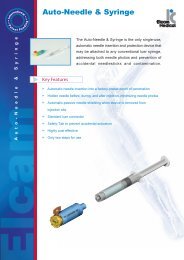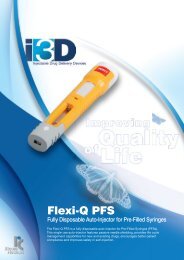Flexi-Q DV Auto-injector Case Study - DALI Medical Devices
Flexi-Q DV Auto-injector Case Study - DALI Medical Devices
Flexi-Q DV Auto-injector Case Study - DALI Medical Devices
- No tags were found...
You also want an ePaper? Increase the reach of your titles
YUMPU automatically turns print PDFs into web optimized ePapers that Google loves.
Visit us @ Booth 320<strong>Flexi</strong>-Q <strong>DV</strong> <strong>Auto</strong>-<strong>injector</strong><strong>Case</strong> <strong>Study</strong>:Lessons Learned fromDevelopment of a Unique<strong>Auto</strong>-<strong>injector</strong> -Till 510(k) ClearanceDavid Daily,Director for BD and R&D
Elcam customers are the leading U.S. &European medical device companies4
Project History -General Top Level Overview2003 -20042004 -20052005 -20092009Feb2012I3DinitiativeFeasibilityFUDAIPFS+<strong>DV</strong>,SEDAI, AN:Prototypes, IP,road show at9 pharmas(EU+US)DevelopmentFocusedinitially on <strong>DV</strong><strong>Flexi</strong>-Q PFS– FDADeviceMaster File(MAF)<strong>Flexi</strong>-Q <strong>DV</strong>– 1 st 510(k)Submission<strong>Flexi</strong>-Q <strong>DV</strong>– 510(k)CLEARED7
Initial Development Phase• Developed with a major pharmaceutical company• Drug in vial (expensive)• Generally elderly patient population (50-75 years)• Frequent or infrequent injections• Market transition from injection by healthcareproviders to self-injection at home• Design Concept: a Plunger Rod is used to fill thedrug from the vial into the <strong>injector</strong>8
The Problem• In a usability study performed in the U.S. with 28participants, occasionally, some people pushed on thePlunger Rod instead of pressing the Inject Button foractivation (while not looking at the instructions for use)• Result: Spillage of expensive drug• Conclusion of our Pharma partner: Our 1st mitigationisn’t effective enough…Oops… What dowe do now???10
Chosen Solution1. Implementing a Design Change:– Adding a proprietary feature* – Plunger Locker– Allows manual Plunger Rod manipulation for drugreconstitution and aspiration– Prevents expensive drug spillage during injection -Locks plunger while not reconstituting orautomatically injecting2. Adding Device Labeling:– “INJECT” print on the Trigger Button* International patentapplications filed11
Verification TestsPerformance Testing: Forces• Retraction to enable injection• Button Activation• Needle Shield Protection• etc.NS ProtectionunderSide ForcePerformance Testing: Syringe related• Injection Time• Dead Volume• Needle Penetration Depth• etc.Pre-Conditioning:• Storage Environmental Conditions• Dry Heat Atmosphere (70°C)• Cold Storage Atmosphere (-40°C)• Drop 1m height• Transportation - Shipping &HandlingPerformance Testing: Shelf Life• Accelerated Aging• Stability Tests12
Needle Shield Protection under Side Force• Specific test protocol• Acceptance Criterionaccording to product SPEC• Special designed fixtures13
Device and Changes Validation• Simulated Clinical Use (Summative) <strong>Study</strong>• Performed based on the FDA CDRH Guidance:“<strong>Medical</strong> <strong>Devices</strong> With Sharps Injury PreventionFeatures”14
<strong>Study</strong> Methodology - Brief1. <strong>Devices</strong> tested:500 units of <strong>Flexi</strong>-Q <strong>DV</strong> auto-<strong>injector</strong>s2. 30 total naïve participants recruited:– 5 participants being mild to moderate RA/MS patients– Male and female aged 18-70 years old3. Each participant operated 15-17 <strong>Flexi</strong>-Q <strong>DV</strong>’s:– Injecting into foam-pad positioned:on her/his thigh (~½);on her/his abdomen (~½);15
Results1. No drug spillage has occurred(0/500 operations)2. Solution unrelated to labeling – no matter ifreading IFU…!3. Successful study510(k) submission (Jul’ 2009)July200916
Pre-IDE• FDA review: Main issue was related to theUsability <strong>Study</strong> (Feb’ 2010)• New Usability <strong>Study</strong> protocol was submitted aspart of pre-IDE meeting (Nov’ 2010) to avoid“surprises” in a new 510(k) submissionJuly2009Feb’2010Nov’201017
Usability Studies• Previous Issue:– Failure to accurately aspirate 1.0 mL (±5%) of solution– Related to patient/user performance – not auto-<strong>injector</strong>functionality• Mitigation- Elcam instituted design change:– Dosing graduation line color was changed– Dosing graduation line thickness was enhanced• Elcam proposes to perform Summative Usability study:– Success of the design change mitigation– 60 devices operated by 10 participants (healthy and patients)– Comparison of usability to standard syringe (predicate device) andquantitative measurements18
Usability <strong>Study</strong>• Question to CDRH:Does the Agency agree that successful performance ofthe proposed summative usability study protocol, alongwith the two previous studies will be sufficient toestablish the usability of the device?• Agency answer:Never agrees… but accepted the overall approach.Asked to add clarifications to Risk Assessmentdocument, delay between training and trial injection,etc.19
New 510(k) submission• Usability <strong>Study</strong> was performed as agreed in pre-IDEmeeting• 100% success to perform all activation steps• Proved significantly better <strong>Flexi</strong>-Q <strong>DV</strong> efficiency andaccuracy compared to standard syringe• New 510(k) submission (May 2011)• Yet, CDRH requested additional information(July 2011)July2009Feb’2010Nov’2010May2011July201120
<strong>Study</strong> Participants• Procrit ® - was identified as one of the approved drugs compatible withthe <strong>Flexi</strong>-Q <strong>DV</strong> auto-<strong>injector</strong>• The Self-Injecting patient population chosen to establish usability wasCancer Patients undergoing chemotherapy (potentially treated withProcrit ® )• The two User Groups:– Self-Injecting Patients– Non-Professional Caregivers• 15 participants from each group• Representation of younger, middle, and older-aged participants. Maleand Female. Experienced and naïve.• HCPs were not included23
<strong>Study</strong> Procedure• Training by Health Care Professional (registered nurse)• Up to 3 practice sessions. HCP presence, questions areallowed• 1 st trial injection - Observed Practice Injection.observations documentation by moderator• Short lunch break and a distracter task• 2 nd trial injection - Simulated Home Injection (TrainingRetention). observations documentation by moderator25
<strong>Study</strong> Results• Observed Practice Injection Results (before break):– 29 of the participants performed the critical steps without errorsor close calls, and completed the injection with a full dose– Patient #9 did not properly perform step 8, setting the dosewhich would result in an under dose– When asked after the injection, the patient stated that she didnot need the IFU and the errors were because she was rushingand was not concentrating• Simulated Home Injection Results (after break):– All of the participants performed the critical steps without errorsor close calls, and completed the injection with a full dose– Patient #9 used the IFU and performed all tasks successfully26
<strong>Study</strong> Conclusions• The study results establish that the users can perform all criticaltasks without a pattern of preventable use error after training decay• All of the participants who read and followed the IFU were able touse the <strong>injector</strong> successfully• A small residual risk remains that certain patients may ignore thetraining and instructions which may result in mis-dosing.This risk is one that cannot be eliminated through design orlabeling changes and is a risk that is residual for almost allinjectable drugs, regardless of delivery system (even in prefilledsystems)• Additional information submission to FDA (Jan’ 2012)July2009Feb’2010Nov’2010May2011July2011Jan’201227
FDA 510(k) Clearance• SE letter (Feb 2012)July2009Feb’2010Nov’2010May2011July2011Jan’2012Feb’201228
<strong>Flexi</strong>-Q <strong>DV</strong> Design Characteristics -Pharmaceutical Customer AdvantagesDifferentiation:• Unique auto-<strong>injector</strong> for drugs in vials• Compatible with drugs withdifferent administration volumes<strong>Flexi</strong>-Q <strong>DV</strong>R and P-<strong>DV</strong>R versions*:• Allow reconstitution of multiple vialsfor increased drug dosing / mixing• Provides flexibility – the diluents may bein either vials or pre-filled in the <strong>injector</strong>* Require additional submission(s)29
<strong>Flexi</strong>-Q <strong>DV</strong> Design Characteristics -Patient Advantages - Ease Of UseBetter Patient Compliance:• Quiet injection - reducing anxiety andperceived pain• A fully automatic injection process• Prevents needle-phobia• Easy drug aspiration and expellingof air bubbles30
<strong>Flexi</strong>-Q <strong>DV</strong> Design Characteristics -Patient Advantages - Safety• Prevents needle-stick injuries• Reduced local skin reactions• Clear visual and audible confirmations• Prevents expensive drug spillage duringreconstitution and injection (IP)• Prevents false trigger activation duringall steps31
Lessons learned• Formative <strong>Study</strong> vs. Summative <strong>Study</strong>• No need for quantitative measurements in the usabilitystudy!!!• 100% success only in steps which were identified as critical(Risk Assessment). In other steps failures are allowed aslong as they are not systemic.• HAQ as acceptable approach for disease level classification.• Provide documentation in a format that is consistent with therecent release of the New Draft Human Factors Guidanceeven-though still a “draft”.• Pre-IDE does not guarantee zero issues with FDA…32
Visit us @ Booth 320Summary: Elcam <strong>Medical</strong>• Differentiator• Fight drug counterfeiting• Improved life-cycle management• IMPROVED Patient ComplianceYou needUnique, Customizable NEW GENERATION <strong>Flexi</strong>-Q linefor low-high viscosity, liquid or lyophilized,for both Pre-filled Syringes & Vials33
Acknowledgments• P/L Biomedical, Mr. Lee Leichter• Radius Product Development, Ms. Christina Mendat, Mr.Sean Phillips• Talmed ltd., Ms. Tali Hazan• Our colleagues:Guy Keenan – device testingLior Raday, Udi Carmel, Micha Segev, Amotz Porat – R&DShay Shaham, Ms. Sina Harshuk – QA &RAAmit Shlezinger, Yuval Paz - Operationsand many others…34
Contacts• Dr. Menachem Zucker, VPHead of Injectable Drug Delivery <strong>Devices</strong> (I3D)menachem@elcam.co.il• David Daily,Director for R&D and BD, I3D, Elcam <strong>Medical</strong>CEO, <strong>DALI</strong> <strong>Medical</strong> <strong>Devices</strong>ddaily@dalimed.com35
Visit us @ Booth 320Thank You













